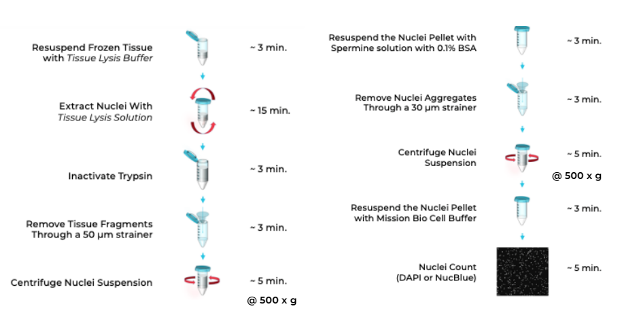Single cell sequencing has been at the forefront of industry and academia alike since its invention. The ability to discern differences in cell populations at a true single cell level has unlocked an indispensable amount of information that is driving the future of precision medicine and the eventual eradication of disease. However, depending on your sample type, one of the most challenging aspects of conducting single cell sequencing is right at the beginning of the workflow – sample preparation.
The ability to create single cell suspensions is key to successfully performing single cell sequencing. Primary solid tumor tissue in particular, is notoriously difficult to work with. The most notable issues being small sample sizes and inability to work with fresh tissue. Snap freezing or OCT embedding tissues are the most common forms of preservation. However, these methods add an additional layer of complexity to sample preparation. Some researchers have addressed the issue of small sample size by expanding their primary sample in PDX or organoid models, but this is not feasible for all. An alternative to isolating single cells is isolating single nuclei.
At the end of March 2022, Mission Bio announced the launch of the Tapestri Solution for Solid Tumor Research. This end-to-end solution enables researchers to design, prepare, run and analyze their samples to detect copy number and single nucleotide changes with single-cell resolution. Along with this launch, a newly developed and improved nuclei isolation protocol was released and is available for download here.

Abbreviated schematic of Mission Bio enzymatic nuclei isolation protocol
This comprehensive protocol has been extensively tested against many tissue types and can be used as a universal backbone for all tissue types. In addition to the protocol, here are some tips and tricks to maximize your success processing your samples:
- Attaining the proper pH for the spermine solution is key to the success of your digestion. Add 1M HCl VERY slowly till pH 7.6 is achieved. Do not overshoot!
- Do not exceed the noted shelf life of formulations, if it’s past, make fresh.
- Ensure tissue is adequately minced prior to proceeding with enzymatic digestion. Tissue fragments should be able to pass through the tip of a standard bore P1000.
- Digestion time for your particular sample type will require close optimization:
- It would be best to perform a trial run when handling very precious samples. This will protect sample integrity prior to running on Tapestri.
- Check digestion progress every 5 minutes.
- Though we recommend not exceeding 15 minutes of incubation, up to 20-25 minutes can be appropriate for certain indications.
- Assess quality of nuclei digestion using fluorescence markers (Appendix B of MB Nuclei Extraction protocol) prior to running Tapestri.
For more information and to hear fascinating work leveraging the Tapestri technology, please get in touch with us here.










